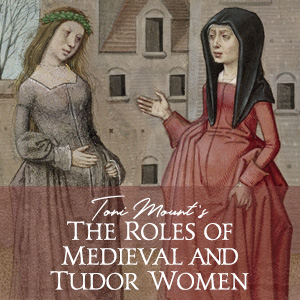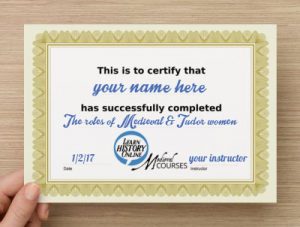 In this 12-unit course from historian Toni Mount, we shall be exploring the lives of Medieval and Tudor women of all classes, looking at relationships, earning a living, caring for the family and responsibilities in the home. Life was not easy but we shall be thinking about how women did manage and what they could do, rather than the limitations put upon them. Using a wide range of original source material, this course will bring into focus how our doughty ancestors lived, loved, laboured and, eventually, met their Maker.
In this 12-unit course from historian Toni Mount, we shall be exploring the lives of Medieval and Tudor women of all classes, looking at relationships, earning a living, caring for the family and responsibilities in the home. Life was not easy but we shall be thinking about how women did manage and what they could do, rather than the limitations put upon them. Using a wide range of original source material, this course will bring into focus how our doughty ancestors lived, loved, laboured and, eventually, met their Maker.
Note: This is an online course of downloadable or streaming audio lectures (plus transcripts) which can be done in your own time and you have lifetime access to the course once you have signed up and paid. There is no set start or end date, you can do it at your own pace. It is open internationally.
Click on "Full description" to find out more and click on the "Buy Now" tab to sign up and purchase.
- Buy NOW
- What's included
- Course Expert
- Reviews
- Questions
- Gift Certificate
($49 is approximately £36.50/€42.00/74.90AUD)

- 310 minutes (5 hours 10 minutes) of audio lectures.
- 12 lessons - streaming audio or downloadable audio mp3 files.
- Downloadable PDF transcripts of each lesson.
- End of unit quizzes.
- A further reading list.
- End-of-course certificate posted to you.
 Toni Mount is an author, history teacher and an enthusiastic life-long-learner. She's a member of the Research Committee of the Richard III Society and a library volunteer where she leads a Creative Writing group. She attends history events as a costumed interpreter.
Toni Mount is an author, history teacher and an enthusiastic life-long-learner. She's a member of the Research Committee of the Richard III Society and a library volunteer where she leads a Creative Writing group. She attends history events as a costumed interpreter.
She earned her research MA from the University of Kent in 2009 through her study of a medieval medical manuscript held at the Wellcome Library in London. Her BA (with First-class Honours) and her Diploma in European Humanities are from the Open University. Her Cert. Ed (in Post-Compulsory Education and Training) is from the University of Greenwich. Recently, she completed a Diploma in Literature and Creative Writing with the Open University. She's currently studying a range of modules on contemporary science and technology also with the OU.
Toni has written and published books including The Medieval Housewife & Other Women of the Middle Ages, Dragon's Blood & Willow Bark : The Mysteries of Medieval Medicine, Everyday Life in Medieval London, and Richard III King of Controversy. She is also the author of the Sebastian Foxley Medieval Mystery Series.
 After purchasing this gift certificate you will be redirected to a page with a printable gift certificate code. This code will enable the user to have FULL ACCESS to the course you have chosen, when redeemed.
After purchasing this gift certificate you will be redirected to a page with a printable gift certificate code. This code will enable the user to have FULL ACCESS to the course you have chosen, when redeemed.
Make the day of a history lover with these gift certificates...
CLICK HERE TO BUY
| Module 1 | Medieval Housewives - Caring for your Husband | |
|---|---|---|
| Have you ever wondered what life was like for the ordinary housewife in the Middle Ages? How did she manage the daily round of cooking, cleaning, shopping and looking after her husband and children? How do we know? Toni uses some contemporary sources to answer these questions. | ||
| Unit 1 | Introduction and Medieval Housewives - Caring for your husband | |
| Module 2 | Medieval Housewives – Childcare, Food & Drink | |
| Until they were seven years old, children were thought to lack moral reasoning and were in need of particularly close attention. It was part of the duties of the godparents, as promised at baptism, to keep their godchildren safe from fire and water – in an age of open fires and unguarded pots of boiling water, accidents could and did happen so easily. Toni looks at the types of accident that happened to rural and city children, before moving on to looking at food: the growing of it, shopping for it, preparation and presentation of it, all of which was either down to the housewife herself or, in the case of the wealthy, down to her direction of the servants. | ||
| Unit 1 | Medieval Housewives - Childcare, food and drink | |
| Module 3 | Peasant Women – Country women in fact & fiction | |
| During the medieval period, the majority of the population of England could have been described as 'peasants'. In this lesson, Toni looks at what a peasant actually was, what rights they had and what peasant life was like, particularly for women. She considers real-life peasant women from the sources, as well as those from literature of the day. | ||
| Unit 1 | Peasant Women - Country women in fact and fiction | |
| Module 4 | Peasant Women – Effects of the Black Death & Manor Courts | |
| In 1348, the Great Pestilence, or the Black Death, arrived in England on the Dorset coast. In this lesson, we look at the drastic effect it had on the lives of the peasants in the years following. Toni also examines Manor Court rolls from the period and what they tell us about the lives of peasant women, and some of the misfortune they could encounter | ||
| Unit 1 | Peasant Women - Effects of the Black Death and Manor Courts | |
| Module 5 | Women in Trade – Silkwomen and shopkeepers | |
| Before the Industrial Revolution and the move towards large-scale factory output, towns were primarily centres of trade where manufacturing and production went on in small domestic workshops. Sales tended to be direct from the producer to the customer. So where did women fit into these various commercial ventures? Toni looks at real-life women who worked as silkwomen, shop-keeper, blacksmiths and bell-founders, as well as those who helped their husbands with his business. | ||
| Unit 1 | Women in trade - silkwomen and shopkeepers | |
| Module 6 | Women in Trade – Femmes soles, femmes couvertes and less respectable traders | |
| In this lesson, Toni looks at the different ways in which women traded - as femmes soles or femmes couvertes, as well as looking at women who worked as regrators, forestallers, hucksters and prostitutes. | ||
| Unit 1 | Women in Trade - Femmes soles, femmes couvertes and less respectable traders | |
| Module 7 | Ladies of Rank – The literary ideals | |
| In the medieval world, the lady of the upper classes was important in many ways. In the ideal of chivalry, she was the adored one, the source of all romance and inspiration, the object of worship. She had but to command, and she would be obeyed, and all deeds of valour would be performed for her. On a more realistic level, in law and in feudal society, she was primarily important as a landowner. In the family she was important as a wife and mother, wielding great practical authority, not only in her own sphere of the home but in a much wider sphere as her husband’s representative during his absence. Toni looks at what medieval literature says about this class of woman, and what kind of "instruction" was given for young ladies. | ||
| Unit 1 | Ladies of Rank - The literary ideal | |
| Module 8 | Ladies of Rank – Real lives, Sumptuary Laws & fashion | |
| Toni starts this lesson by looking at how women were seen as such morally weak creatures that physical punishment was required to help them see the error of their ways. She considers real-life women who were different from the ideals of their day, before moving on to considering dress and fashion in the medieval period, and how Sumptuary Laws were developed to make people dress to their status or class. | ||
| Unit 1 | Ladies of Rank - Real lives, Sumptuary Laws and Fashion | |
| Module 9 | Women and the Church – Religious attitudes towards women | |
| During the Middle Ages, women were a subject of great confusion for the Church: how should they be regarded? Were they to be treated as the absolute inferiors of men or equal in the sight of God? Were they basically good or evil creatures? Were they like Eve or the Virgin Mary? Toni considers how women were depicted in religion before looking at examples of women who became nuns and the attitudes of laywomen to religion. | ||
| Unit 1 | Women and the Church - Religious attitudes towards women | |
| Module 10 | Women and the Church – Religious change | |
| In the late fourteenth century, attitudes to religion were beginning to change with women sometimes taking a very active role. Toni examines the lives of Margery Kempe and Cecily Neville, as well as looking at examples of the piety of women as evidence in their wills. She finishes by considering what impact religious reform, such as the dissolution of monasteries, had on women, both nuns and laywomen. | ||
| Unit 1 | Women and the Church - Religious change | |
| Module 11 | Tudor Wives – Childbirth & childcare | |
| For women of the medieval and Tudor periods who had survived childhood and were destined for marriage, childbirth was going to be one of the greatest hazards they would probably face. Statistics show that if a woman survived her child-bearing years, she had a reasonable chance of living her biblical span of three-score-years-and-ten, i.e. into her seventies. But what were pregnancy and childbirth like for medieval women and how did they care for and educate their children? | ||
| Unit 1 | Tudor Wives - childbirth and childcare | |
| Module 12 | Tudor Wives – 'A woman's work is never done!' | |
| When we read English history, it is often separated into the 'Medieval' and 'Tudor' periods, divided at the year 1485, when Henry Tudor defeated Richard III, the last Plantagenet king, at the Battle of Bosworth. But this convenient packaging of history into pigeon-holes doesn't reflect the way people at the time went about their daily lives. Life for the lesser subjects of the first Tudor monarch, Henry VII, continued much as it had for centuries. But what was this life like? Toni looks at the daily chores of a Tudor housewife and how some of these changed during the Tudor period. She also considers the impact that male unemployment had on women traders. | ||
| Unit 1 | Tudor Wives - A woman's work is never done | |
